Hacienda tokens from Yucatán (the Peón family)
The Peón family was a distinguished patrician family that settled in the Yucatán Peninsula in the eighteenth century and could claim descent from Francisco de Montejo, the Spanish conquistador who had led the Yucatán campaign. Throughout the colonial period, the Peón and Cámara families had been the principal landowners in the Yucatán peninsula, owning vast tracts of property.
With wealth based in large landed estates acquired before the boom, the Peons expanded their stake in the regional economy by participating in a variety of businesses and industries. Although they did not date back to the original conquistadors of Yucatán, as several local families claimed to do, their prominence and long-standing tenure in eighteenth- and nineteenth-century Yucatecan society qualified them as gente decente (“respected people”).
The Porfirian generation of Peóns, despite their aristocratic trappings, did not merely accept the intrusion of wealthy henequen merchants into their coterie of respected families, but actively engaged in business partnerships, social amenities, and intermarriage with nouveaux riches entrepreneurs.
The Peóns, lacking an all-powerful figure like Olegario Molina, relied instead on sophisticated subregional empires that permitted them to control all phases of henequen production within certain geographical areas. Hence, various wings of the Peón family not only were the largest land-owners in a particular subregion, but they exercised considerable control over local marketing practices, transport networks, and sources of all-important mortgage capital. This dominance assured the Peóns flexibility in fibre shipments, control over every phase of the marketing cycle from field to warehouse, and, with the uncertain status of fibre price fluctuations, a free hand to speculate in a rapidly changing real estate market. In this fashion, the Peón y Peón wing dominated western Hunucmá and Mérida partidos (about 5 to 10 kilometres west of Mérida), the Peón y Regil brothers rivaled the Molina holdings in Tixkokob municipio (25 kilometres east of Mérida), while the Peón-Losa, Domínguez Peón, and Peón Cetina wings combined to gain a strong foothold in Maxcanú (60 kilometres southwest of Mérida).
Carlos Peón Machado
Carlos Peón Machado was born in Mérida, in 1859, the second son of Felipe Peón Machado and María Machado y Machado. His sister, Nicolasa, was the wife of Eusebio Escalante. Later, Peón's daughter, Sara Peón Suárez would marry Eusebio Escalante Peón, the son of Eusebio Escalante Bates and Nicolasa Peón Machado.
Carlos married María de la Concepción Suárez Villamil, daughter of Joaquín Suárez Cámara, a wealthy landowner related to the Cámara family, and María Villamil Vales.
Before becoming a politician, Peón acted for twelve years as the administrator of his father's estates, which included Hacienda Tabi, a sugarcane mill that he had industrialized importing a steam engine and decauville railways. Starting in 1873, he also acquired the Hacienda Temozón, one of the most important in the region, that was dedicated to the production of henequen and at its zenith had an area of 6,643 hectares and 640 employees. He also participated in several businesses with his brother-in-law Eusebio Escalante. After the death of his father, Carlos Peón became the head of the Peón family.
In 1875 Carlos were elected as Governor afor the period that was to end on 31 January 1878.[2] However, he forced to abandon his in December 1876 when Porfirio Díaz overthrew Sebastían Lerdo de Tejada. In 1894, Peón was elected Governor for the four-year term between 1894 and 1898, being the first civilian to hold this position after a long period of military governments. A firm believer in economic liberalism, during his administration he stimulated economic development through private enterprise, particularly concentrating on promoting the henequen industry in Yucatán.
Upon retiring from political life, Carlos Peón returned to the private sector, where he became a business partner of Eusebio Escalante, his brother-in-law, "in almost all of his companies." Ferrocarriles Unidos de Yucatán, for example, was a profitable railroad company that was controlled by Escalante family and Carlos Peón was appointed chairman of the board of directors.
The panic of 1907 led to the collapse of the Escalante trading house (Casa Escalante), which undoubtedly had a negative effect on Peón's wealth.
He died in Mérida, Yucatán, on 11 September 1923.
Augusto Luis Peón
Augusto Luis Peón, the son of Manuel José Peón Maldonado and his wife Loreto Peón Cano (of the Peón y Peón wing) was the the most successful of all Peóns. He fought for the Maximilian imperialists, but despite their defeat, the Peón y Peón wing (along with fellow Conservatives) did not suffer economically during the Liberal restoration.
Due to the systematic acquisition of large cattle ranches after the Caste War, the Peón y Peón wing was well equipped to take advantage of the ensuing henequen boom. Within eight years (1853-61) Manuel José Peón y Maldonado purchased four large cattle ranches: San Antonio Yaxché, Ulilá, Cheuman, and Balché in western Hunucmá and Mérida partidos. The properties, except for small herds of grazing cattle and some rented corn plots (milpas), were generally undeveloped. Peón y Maldonado’s avowed intention, written into the bill of sale, was to increase those livestock herds. Several years later, he applied to the state ministry of development for a public land grant of four square leagues of adjoining properties and his request was approved by local officials who overrode village objections to the sizeable grants (totaling more than 7,000 hectares).
Manuel José, like many of his contemporaries, gradually transformed these ranches into full-fledged henequen plantations. When he died in 1873, the estates were distributed among his surviving heirs, all of whom continued the process of modernization. Augusto Luis, Manuel’s second son and, after Arturo’s death, the oldest heir, inherited San Antonio Yaxché, the largest of the estates. By the end of the Porfiriato, Augusto had turned the relatively undeveloped cattle ranch that Manuel had purchased in 1853 into one of the largest and most successful henequen plantations in Yucatán. More than any other Peón, Augusto was responsible for creating the subregional empire that the family enjoyed in western Hunucmá and Mérida. His mode of operation was to control or assure control over all factors of production, leaving little to chance, a powerful advantage in an industry that bankrupted as many as it endowed.
First Augusto modernized Yaxché by importing English boilers, American manufactured steam engines, and Yucatecan invented, though United States made, defibering machines to process the fiber. Narrowgage “Decauville” track imported from Belgium was laid throughout the estate, connecting distant fields with the central processing area and thereby improving the plantation’s productivity. The animal-powered tramways also served to join the hacienda with a nearby railway depot, further reducing transport costs.
Augusto also reduced the self-sufficiency of the estate, by limiting corn rental plots and planting nearly all available lands in henequen. By the 1880s, Yaxché, like other henequen estates, found itself importing corn, beans, and other staples from other parts of Mexico or the United States in an effort to feed its growing labour force. This was recruited from nearby villages and bolstered by indentured immigrants from other parts of Mexico, the Caribbean, and the Far East.
Following in his father’s footsteps, Augusto continued to expand Yaxché’s borders. He used two techniques, each representative of methods employed by many Yucatecan hacendados. First, he acquired land when the federal government ordered the dismemberment of corporate landholdings such as village common lands (ejidos) by buying out individual recipients, and second, he bought out neighbouring estates. Often he would loan nearby planters mortgage capital and then repossess their holdings when they defaulted on their payments. In 1896, for example, Augusto and his sister Loreto, during a bust cycle in the regional economy, made seven loans within a span of weeks to local hacendados in nearby Ucu and Caucel. Several years later the haciendas were forfeited to the Peóns when the overmortgaged planters failed to meet their payments. Within thirty years of his inheritance of San Antonio Yaxché, Augusto tripled the size of the estate (to more than 6,000 hectares) by outright purchase, assimilation of parcelled village lands, and mortgage-credit default of neighbouring landlords.
Peón also invested in the railway network and in warehouses in Mérida and Progreso to store the henequen, thus acting as a broker as well as a planter and shipper.
Many henequeneros overextended themselves with second and third mortgages and Peón, who possessed sufficient capital to play the role of creditor, often was able to assume control of properties by default. In the 1907 fiscal crisis, for example, he acquired haciendas in nearby Uman (Hacienda Tedzidz), Ticul (Yokat), and Tekax (Polyuc). In all three cases, Augusto had extended mortgages during the boom years of 1898-1904. As the market price of fiber declined, the regional economy faltered, land values plummeted, capital became scarce, and planters were unable to pay their creditors. In the case of Hacienda Yokat, Peón was forced to sue the proprietor, Fernando García Fajardo. The court forced the debtor to forfeit Yokat to Peón at a fraction of its “real” value. A year later, after fiber prices had recovered, Augusto sold the hacienda to three entrepreneurs for 600,000 pesos.
Peón did invest in local commerce and industry. Besides participating on the first board of directors of the Banco Mercantil (the first bank established in the peninsula in 1890), he also bought shares in a variety of joint-stock enterprises. Augusto also played a role in Molina’s gubernatorial administration, acting as both president of the Mérida town council (ayuntamiento) and later jefe politico of Mérida partido.
Augusto L Peón owned multiple haciendas at Cheumán, Elená, Hobonyá, Mucuyché de Peón, Sabacalá, Sotuta de Peón, Uayalceh de Peón, Yaxché de Peón, Xdul and elsewhere (Bagundo Crespo lists these three tokens under Hacienda San Antonio Tedzidz).
Fincas de A. L. Peón
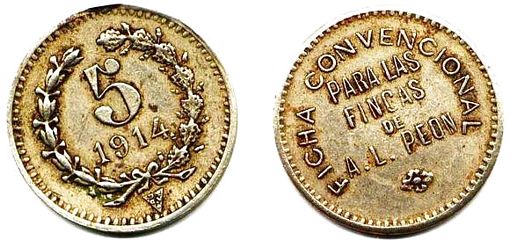
Grove 1388
Obverse: FICHA CONVENCIONAL / PARA / LAS / FINCAS / DE / A. L. PEON
Reverse: 5 / 1914
17 mm. nickel
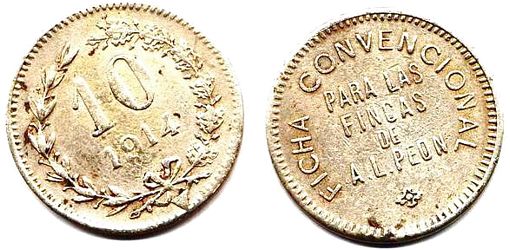 Grove 1389
Grove 1389
Obverse: FICHA CONVENCIONAL / PARA / LAS / FINCAS / DE / A. L. PEON
Reverse: 10 / 1914
22 mm. nickel
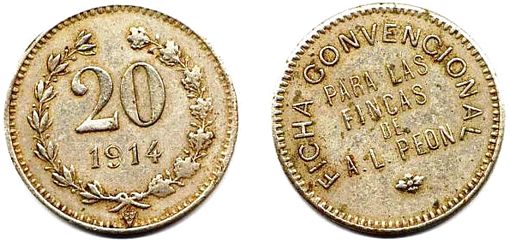 Grove 1390
Grove 1390
Obverse: FICHA CONVENCIONAL / PARA / LAS / FINCAS / DE / A. L. PEON
Reverse: 20 / 1914
20 mm. nickel
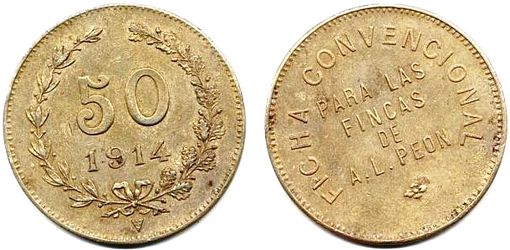 Grove 1391
Grove 1391
Obverse: FICHA CONVENCIONAL / PARA / LAS / FINCAS / DE / A. L. PEON
Reverse: 50 / 1914
32 mm. nickel
Grove 1392
Obverse: A. L. P.
Reverse: No 5
17 mm. nickel
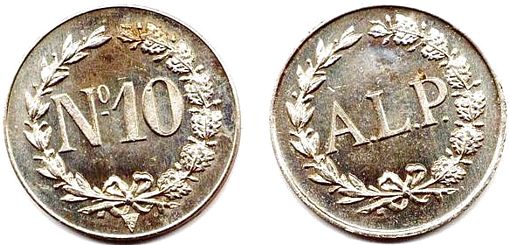 Grove 1393
Grove 1393
Obverse: A. L. P.
Reverse: No 10
22 mm. nickel
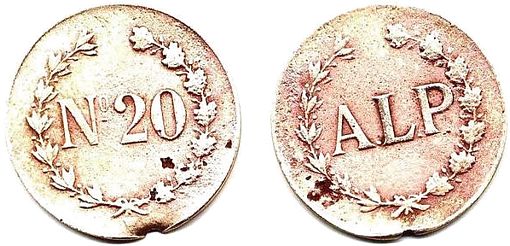 Grove 1394
Grove 1394
Obverse: A. L. P.
Reverse: No 20
25 mm. nickel
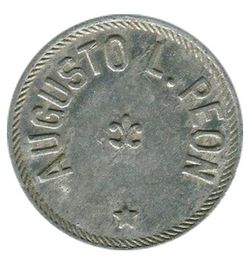
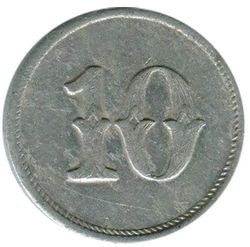
Grove 1395
Obverse: AUGUSTO L. PEON
Reverse: 10
20 mm. aluminum
Grove 1396
Obverse: AUGUSTO L. PEON
Reverse: 20
29 mm. aluminum
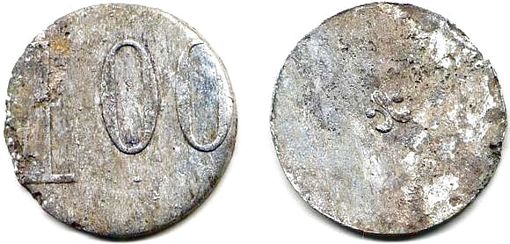 Grove 1397
Grove 1397
Obverse: a fleur-de-lis
Reverse: 1 00
21 mm. aluminum
Finca Yaxché
This finca was situated in the municipio of Ucú.
Grove
Obverse: above a laurel leaf, YAXCHE / ¼ / 1888
Reverse: FICHA CONVENCIONAL / PARA LAS / FINCAS / DE / A. L. PEON
17 mm. nickel
Grove
Obverse: above a laurel leaf, YAXCHE / ½ / 1888
Reverse: FICHA CONVENCIONAL / PARA LAS / FINCAS / DE / A. L. PEON
22 mm. nickel
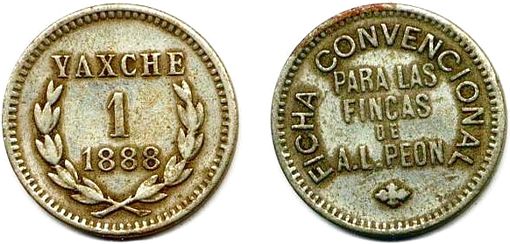 Obverse: above a laurel leaf, YAXCHE / 1 / 1888
Obverse: above a laurel leaf, YAXCHE / 1 / 1888
Reverse: FICHA CONVENCIONAL / PARA LAS / FINCAS / DE / A. L. PEON
24 mm. nickel
J. M. Peón
Finca Tankuche
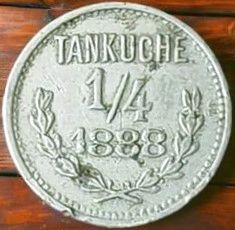
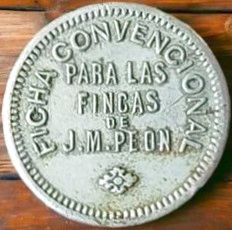
Grove 1410
Obverse: above a laurel wreath TANKUCHE / ¼ / 1888
Reverse: FICHA CONVENCIONAL / PARA LAS . FINCAS / DE / J. M. PEON
17 mm. nickel
Grove 1411
Obverse: above a laurel wreath TANKUCHE / ½ / 1888
Reverse: FICHA CONVENCIONAL / PARA LAS . FINCAS / DE / J. M. PEON
17 mm. nickel
Lorenzo Peón
Hacienda Ticopó
This hacienda is located in the municipio of Acanceh, 25 kilometres southeast of Mérida on the main road to Valladolid. In 1888 the hacienda was owned by Lorenzo Peón.
Grove 1628
Obverse: around a henequen plant HACIENDA TICOPO / L. PEON
Reverse: FICHA CONVENCIONAL / 1/4 / REAL / 1888
18mm. nickel
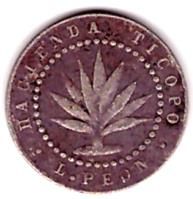
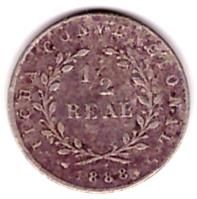
Grove 1629
Obverse: around a henequen plant HACIENDA TICOPO / L. PEON
Reverse: FICHA CONVENCIONAL / 1/2 / REAL / 1888
21mm. nickel
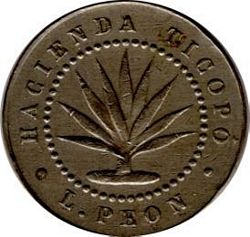
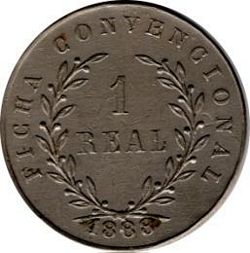
Grove 1630
Obverse: around a henequen plant HACIENDA TICOPO / L. PEON
Reverse: FICHA CONVENCIONAL / 1 / REAL / 1888
25mm. nickel
Bagundo Crespo also lists fichas for 1 mecate, 2 mecates, 3 mecates, 5 mecates, 250 pencas, 500 pencas, 1000 pencas and 2000 pencas. such as
Obverse: 2000/ PENCAS / TICOPO / M. C. G.
Reverse:
50 x 63mm.
Miguel Peón
Hacienda San Bernardo
San Bernardo is located in the municipio of Maxcanú.
Obverse: HACIENDA SAN BERNADO / MIGUEL PEON
Reverse: 500 / PENCAS
29mm. aluminum
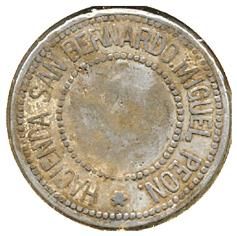
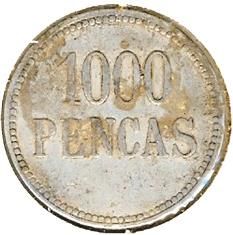
Obverse: HACIENDA SAN BERNADO / MIGUEL PEON
Reverse: 1000 / PENCAS
29mm. aluminum
Grove 1562
Obverse: HACIENDA SAN BERNADO / MIGUEL PEON
Reverse: ½ / MECATE
19mm. aluminum
Obverse: HACIENDA SAN BERNADO / MIGUEL PEON
Reverse: 1 / MECATE
21mm. aluminum
